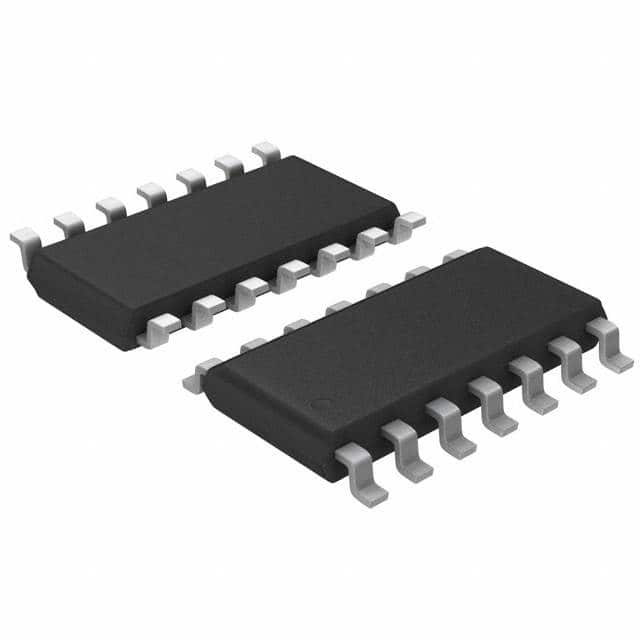Encyclopedia Entry: 74VHC164MX
Product Overview
- Category: Integrated Circuit (IC)
- Use: Shift Register
- Characteristics: High-speed, low-power consumption
- Package: SOIC (Small Outline Integrated Circuit)
- Essence: Serial-in, parallel-out shift register
- Packaging/Quantity: Tape and Reel, 2500 units per reel
Specifications
- Supply Voltage: 2.0V to 5.5V
- Logic Family: VHC (Very High-Speed CMOS)
- Number of Stages: 8
- Maximum Clock Frequency: 74 MHz
- Output Current: ±6 mA
- Operating Temperature Range: -40°C to +85°C
Detailed Pin Configuration
The 74VHC164MX IC has a total of 14 pins, each serving a specific function: 1. GND: Ground 2. QH' (Pin 9): Complementary output of the last stage 3. SER (Pin 10): Serial data input 4. QA (Pin 11): Parallel output A 5. QB (Pin 12): Parallel output B 6. QC (Pin 13): Parallel output C 7. QD (Pin 14): Parallel output D 8. CLK (Pin 1): Clock input 9. MR (Pin 2): Master Reset input 10. QH (Pin 3): Output of the last stage 11. QG (Pin 4): Parallel output G 12. QF (Pin 5): Parallel output F 13. QE (Pin 6): Parallel output E 14. VCC: Positive supply voltage
Functional Features
- Serial-in, parallel-out operation
- Asynchronous master reset
- High-speed data transfer
- Low power consumption
- Wide operating voltage range
- Schmitt-trigger input for noise immunity
Advantages and Disadvantages
Advantages: - High-speed operation allows for quick data transfer. - Low power consumption makes it suitable for battery-powered devices. - Wide operating voltage range provides flexibility in various applications. - Schmitt-trigger input ensures reliable operation in noisy environments.
Disadvantages: - Limited number of stages (8) may not be sufficient for complex applications requiring more parallel outputs. - Lack of built-in error detection or correction mechanisms.
Working Principles
The 74VHC164MX is a serial-in, parallel-out shift register. It receives data serially through the SER pin and shifts it through its internal stages upon each clock pulse received at the CLK pin. The parallel outputs QA to QH provide the stored data in parallel format. The MR pin allows for asynchronous resetting of all stages to their initial state.
Detailed Application Field Plans
The 74VHC164MX IC finds applications in various fields, including: 1. Digital communication systems 2. Data storage and retrieval systems 3. Industrial automation and control systems 4. LED matrix displays 5. Serial-to-parallel data conversion 6. Clock signal distribution
Detailed Alternative Models
Some alternative models that can be considered as alternatives to the 74VHC164MX are: 1. SN74HC164N by Texas Instruments 2. CD74HC164E by Texas Instruments 3. MC74HC164AN by ON Semiconductor 4. 74HC164D by NXP Semiconductors 5. HEF40164BT by Nexperia
Note: This encyclopedia entry provides an overview of the 74VHC164MX IC, its specifications, pin configuration, functional features, advantages and disadvantages, working principles, application field plans, and alternative models.
Lista 10 Vanliga frågor och svar relaterade till tillämpningen av 74VHC164MX i tekniska lösningar
Sure! Here are 10 common questions and answers related to the application of 74VHC164MX:
Q: What is the 74VHC164MX? A: The 74VHC164MX is a 8-bit serial-in, parallel-out shift register IC (integrated circuit) commonly used in digital electronics.
Q: What is the purpose of a shift register? A: A shift register allows you to store and shift data bits serially, making it useful for applications such as data storage, data transfer, and control signal generation.
Q: What is the maximum clock frequency supported by the 74VHC164MX? A: The 74VHC164MX can support clock frequencies up to 100 MHz, making it suitable for high-speed applications.
Q: How many output pins does the 74VHC164MX have? A: The 74VHC164MX has 8 output pins, corresponding to the 8 bits of data stored in the shift register.
Q: Can I cascade multiple 74VHC164MX ICs together? A: Yes, you can cascade multiple 74VHC164MX ICs to increase the number of bits that can be shifted and stored.
Q: What is the power supply voltage range for the 74VHC164MX? A: The 74VHC164MX operates with a power supply voltage range of 2.0V to 5.5V, making it compatible with a wide range of digital systems.
Q: Does the 74VHC164MX have any built-in protection features? A: Yes, the 74VHC164MX includes built-in ESD (electrostatic discharge) protection, which helps safeguard the IC from damage during handling and operation.
Q: Can I use the 74VHC164MX in both CMOS and TTL logic systems? A: Yes, the 74VHC164MX is compatible with both CMOS (Complementary Metal-Oxide-Semiconductor) and TTL (Transistor-Transistor Logic) logic levels.
Q: What is the typical power consumption of the 74VHC164MX? A: The typical power consumption of the 74VHC164MX is low, making it suitable for battery-powered or energy-efficient applications.
Q: Are there any specific application notes or reference designs available for the 74VHC164MX? A: Yes, the manufacturer of the 74VHC164MX typically provides application notes and reference designs that can help you understand and implement the IC in various technical solutions.
Please note that the answers provided here are general and may vary depending on the specific datasheet and manufacturer's documentation for the 74VHC164MX.


